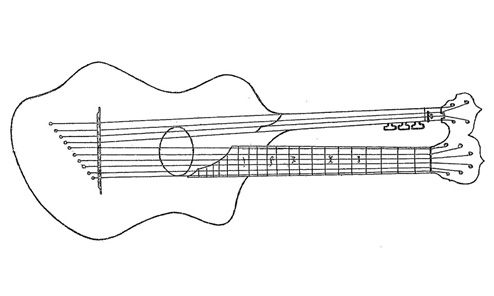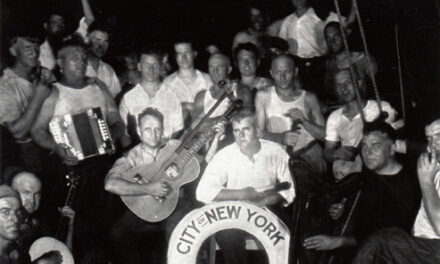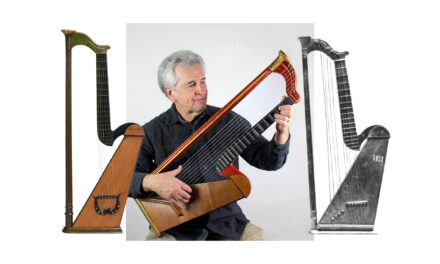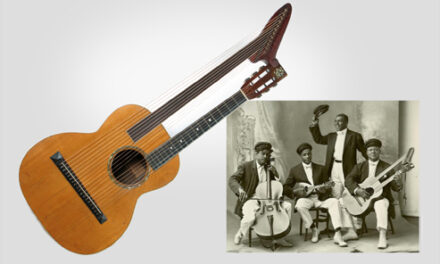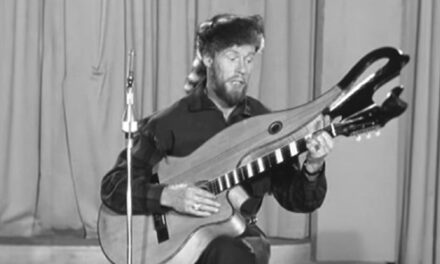Had Guitar Player magazine existed in the 1920s, that’s how I imagine an ad in the back pages would have read.
Until Harpguitars.net, it was difficult to find any mention about inventions designed to “fret” or otherwise change the pitch of a harp guitar’s open strings. I can think of the 1826 Décacorde, and that’s about it. Virtually no other surviving harp guitar shows any sign of tinkering with such mechanisms – they are simply strung with the number of open strings for the notes desired (up to 12 for the oldest “chromatic” harp guitars). Yet the patent page has many such inventions, some brilliant and seemingly simple, some ridiculous, and some inexplicable. With the current interest in sharping levers for sub-basses, I’m surprised no one has tried to adapt any of these forgotten ideas (other than a couple like Fred Carlson, who invents his own ideas).
I’ve just now counted at least 4 patents on the site that feature some method for sub-bass pitch-changing (I’ll list these at the close). Sometimes, they are an added feature to the main invention, but often they are the crux of the entire patent.
In addition to those 4, three of the new recently-discovered patents I mentioned in my blog of Oct 6 feature more ingenious pitch-change systems! I decided to add them to the Patent page one at a time and do a little expanded blog write-up on each at that time.
But first I’ll start with one that has been on the site for a while, but with no analysis, as the text is in French, and was a bit beyond my means. Last year, a generous reader from the U.K. saw my request for a translation of the French patent, and supplied a very good one. Thank you, Daniel Phillips! I only just now stumbled across it, did some slight edits (I think still more accurate translation is needed), and added this to the PDF of the patent, now archived on the site.
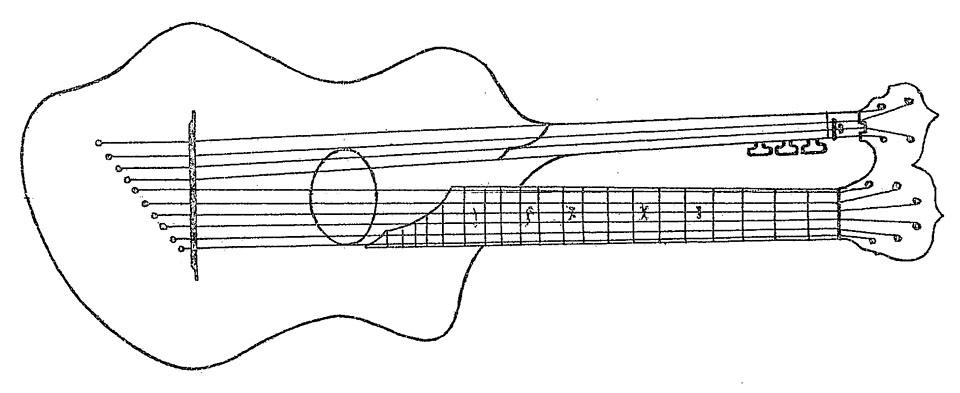
One word that needs no translation is the inventor’s name for his instrument: the superguitare! Such begins French patent # 552,532, invented in 1922 by one Jean-Pierre Anfossi.
In this case, the sub-bass pitch-change device is the last of 4 specific patent features. Frustratingly, they are poorly described and shown – introduced as “a simple, original device, worked by the thumb of the left hand.” The image shows 3 “keys” for the 4 basses, which either flip down or move some component down to “fret” the string at the first semitone. Your guess is as good as mine. The mechanism is described this way:
“The key that you pull down a small way hangs on top of the string, and it strikes expressively on a point from above, and consequently augments the note by a semitone.”
That’s it (“simple, original” is right!). Interesting that the patent was turned down in Italy, then granted in France. I’d think both patent offices would’ve insisted on a little more illustrated information!
Anfossi describes a full chromatic scale (out of 4 strings with unknown tuning), and something about “doubling” the keys. What we see besides the three obvious thumb keys is a line that must represent either a nut (zero fret) or the semitone-sharping fret.
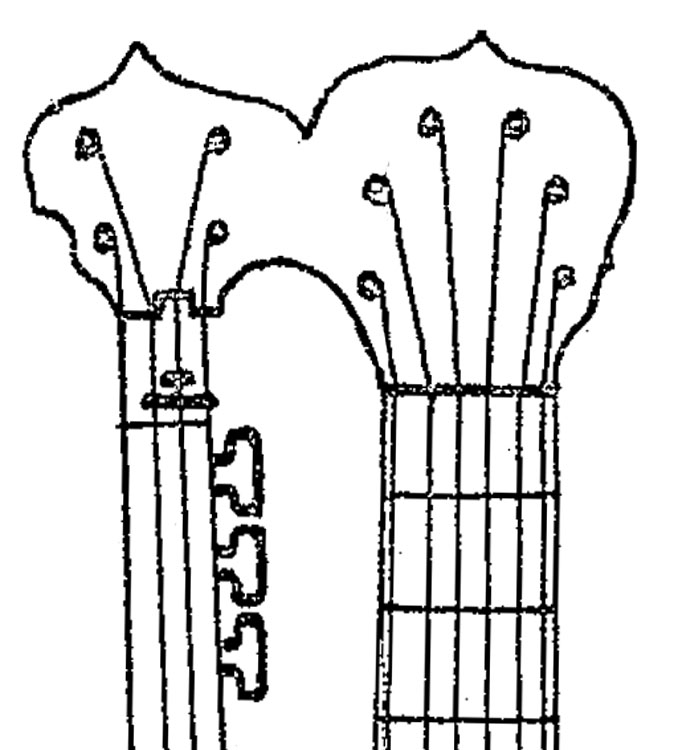
I believe it’s the former, as there is no other straight line (nut) above/behind it (just what is that notch business?). Behind the line he draws a long and short something-or-other, centered on the 2nd highest bass string – the 4th bass apparently gets no sharping ability. He mentions the key “expressively striking” the string from above, implying something pressing the string from above to “fret” it a half-step above. But this would require the device(s) to be on the vibrating side of the nut, not behind it (as there does not seem to be 2 “nuts” as on a Dital harp, for example). I’ve no idea how this worked or how in the world you’d get 12 semitones out of this puzzle.
This troubling passage is no help either:
“You are able to double each key and for each you do not have to lengthen the axis that allows it to pivot to have access to the device in changing position.”
Not sure what to do with that information. Perhaps the original French would help?
“On peut au besoin doubler chaque clé et pour cela on n’a qu’à allonger l’axe qui fait fonction de pivot et répéter ensuite la clé sur le même axe cela pour avoir accès au dispositif tout en changeant de position.”
Perhaps the drawing is completely wrong, and there was a key for 1 semitone, 2 semitones, and the 3rd a “release” key?
“To release the key, you return to the ‘primitive’, normal position.”
Anyone else want to try to crack the code?
Regardless, Anfossi must have built at least a prototype that worked well enough for him to bother including it. I don’t think he just made something up on paper – as there really is nothing on paper. He also adds that you can “make some instruments without the device.”
So the chromatic bass gizmo was really an “extra bonus.” The real meat of the invention is the novel “basic construction founded on a profound acoustic calculation.” Typical patent hyperbole aside, at least one of Anfossi’s ideas seems sensible – specifically, he “displaces the bridge to the right,” meaning he moves the entire bridge to center, so that all 10 strings end up centered on the soundboard. This is of course something harp guitar makers have been weighing and going back and forth on, for centuries (and still today).
He seems to discuss either bridge plates or braces, but does not show them. I believe he is implying that one diagonal brace acts as a sort of “bridge plate,” but is not actually under the bridge, but where the strings are affixed.
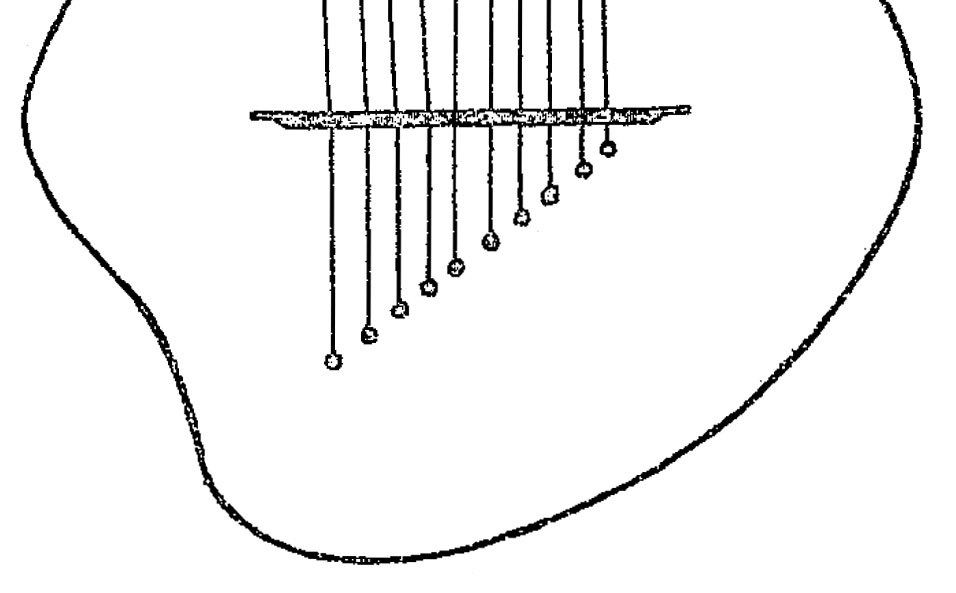
This is his most novel idea: how he tries to excite the top, by terminating each string, not at the bridge, but at a varying distance away from it – the trebles being closest, the last sub-bass being furthest. These then he must be inserting directly into the top, held in with “buttons,” – though he mentions inserting into the bridge as an option also. It reminds me a bit of those recent Babicz guitars.
The final feature is the odd, lumpy body shape itself – altered to accommodate the different string length layout and to achieve Anfossi’s aforementioned “profound acoustic calculation.”
My favorite part of the patent page is coming up with the name that I think best describes the instrument in a nutshell. But with all his features, this would have been the Anfossi “centered bridge, slanted strings-into-top array, key-operated chromatic sub-bass” harp guitar.
So instead I settled on the obvious – and what he named it himself: The Anfossi “super-guitar”!
For Further Reading:
Harp Guitar Patents (the following in order by date):
337,166: Gottfried’s pitch-changing sub-basses harp guitar May 25, 1921
354,922: Rehbach’s Multi-task Sub-bass Harp Guitar (Fixed version and Multi-angle, removable version) Jun 16, 1922
1,184,425: Mouroux open-arm pneumatically-capoed sub-bass harp guitar Feb 2, 1959 (this is another French patent that needs translating)

